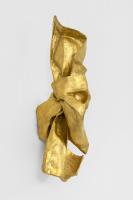Each week, Artful spotlights an art experience or destination that speaks to us right now.
The outstanding Post-Minimalist artist Lynda Benglis has never met a material she couldn't handle with wit and bravura—starting with her floor pieces of poured latex and foam in the late 1960s, which brilliantly one-upped Pollock and other macho drip painters, and continuing into bronze, ceramics, wax, and and even glitter. A much-anticipated survey of her work at the National Gallery in Washington, D.C. that had been scheduled to open last March was postponed due to the pandemic, as was a solo show at the Nasher Sculpture Center in Dallas. In the meantime, however, the high-spirited ingenuity of Benglis's early works is on full display at a three-part gallery exhibition in New York (through December 23) and related online viewing room.
In its Upper East Side townhouse gallery, Cheim & Read is showing several of Benglis's puddle-like "pours" of polyurethane foam along with another inventive body of work from the 1960s and 70s, her lozenge-shaped sculptures layered with pigmented wax. Just upstairs, Ortuzar Projects has assembled wall reliefs of twisted and pleated gold leaf that date from the late 1970s and, although inspired by Byzantine icons the artist had seen in Greece, exude playful irreverence. At another branch of Ortuzar, down in Tribeca, several sculptures from the mid-1970s transform plain cotton bunting by tying it in knots and coating it with sparkles and spray metal. As the art historian and critic Julia Bryan-Wilson writes in an essay for the show's forthcoming catalog, "Benglis grasps the joy of the fake-out, the hard that looks soft, the industrial that becomes pliable and handworked."










